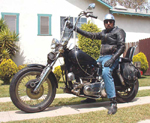
|
|
|
Greetings. By now you're probably familiar with the story of the woman who died in a Phoenix airport holding cell, chained to a bench, after having an emotional outburst related to missing a flight. While there's much still to learn about this case, there are some things we know already that are disturbing. She was on her way to a substance abuse treatment program, and was unaccompanied (if she hadn't been alone, this whole sad event would probably not have taken place). She may, or may not, have been drinking before the incident. Her husband (whom she apparently called before being arrested) desperately tried to inform airport officials that his wife needed assistance and might have become suicidal. And we know that the police on scene chained her up in a small, unmonitored, locked room, left her unattended, and found her some minutes later unconscious and then dead, with her shackles implicated as a possible cause or contributing cause of death. Amazingly, when asked why the room didn't at least have closed circuit camera monitoring so that emotionally disturbed persons wouldn't be left in a vulnerable position -- where they could easily hurt themselves (even fighting with shackles can cause permanent nerve and other injuries) -- the response was that they don't monitor those rooms for privacy reasons. I find this response laughable. We're constantly told by law enforcement how wonderful it is to have surveillance cameras in every nook and cranny outside our own homes, yet cameras in the police stations to monitor in situations like in Phoenix (or to record interrogations for that matter) are fought tooth and nail by those same authorities. I wonder why? Perhaps it would be inconvenient to have a record of what goes on in those rooms -- and during those interrogations? What's more, while in the Phoenix case no Taser was used, we've recently seen an increasing number of cases involving Taser abuse (the Taser is the most popular torture device worldwide, since it can be used without leaving obvious marks). Police agencies have been using the Taser as a quickie control technique, shocking people multiple times even after they're down and handcuffed, and the number of people dying after being Tasered is an ever-growing and increasingly alarming list. There are lots of good cops out there. Unfortunately, it doesn't take a lot of bad eggs to give a black eye to entire departments. More and more, especially post-9/11, we've seen some officers seemingly using terrorism fears as an excuse for their own personal brand of nonconsensual S&M, with Taser abuse and a fetish for overuse of shiny chains and shackles -- even in cases of persons who obviously were in emotional distress and who could have been handled through less extreme means without harm. And as we've seen in the Phoenix case, the unnecessary results can be fatal. Law enforcement is often called a thankless task, and the many dedicated and well-trained officers deserve our appreciation and respect. But that's not an excuse for abusive or even simply inept or cavalier tactics. Such displays are dangerous to the public, and damaging to the reputation of law enforcement itself. It's a lose-lose situation that's in all of our best interests to avoid. --Lauren-- |
Posted by Lauren at October 5, 2007 11:48 AM
| Permalink
Twitter: @laurenweinstein
Google+: Lauren Weinstein